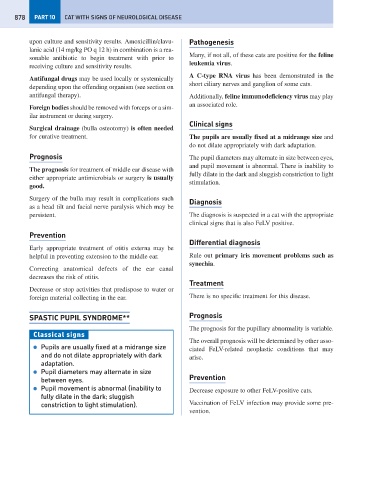Page 886 - Problem-Based Feline Medicine
P. 886
878 PART 10 CAT WITH SIGNS OF NEUROLOGICAL DISEASE
upon culture and sensitivity results. Amoxicillin/clavu- Pathogenesis
lanic acid (14 mg/kg PO q 12 h) in combination is a rea-
Many, if not all, of these cats are positive for the feline
sonable antibiotic to begin treatment with prior to
leukemia virus.
receiving culture and sensitivity results.
A C-type RNA virus has been demonstrated in the
Antifungal drugs may be used locally or systemically
short ciliary nerves and ganglion of some cats.
depending upon the offending organism (see section on
antifungal therapy). Additionally, feline immunodeficiency virus may play
an associated role.
Foreign bodies should be removed with forceps or a sim-
ilar instrument or during surgery.
Clinical signs
Surgical drainage (bulla osteotomy) is often needed
for curative treatment. The pupils are usually fixed at a midrange size and
do not dilate appropriately with dark adaptation.
Prognosis The pupil diameters may alternate in size between eyes,
and pupil movement is abnormal. There is inability to
The prognosis for treatment of middle ear disease with
fully dilate in the dark and sluggish constriction to light
either appropriate antimicrobials or surgery is usually
stimulation.
good.
Surgery of the bulla may result in complications such
Diagnosis
as a head tilt and facial nerve paralysis which may be
persistent. The diagnosis is suspected in a cat with the appropriate
clinical signs that is also FeLV positive.
Prevention
Differential diagnosis
Early appropriate treatment of otitis externa may be
helpful in preventing extension to the middle ear. Rule out primary iris movement problems such as
synechia.
Correcting anatomical defects of the ear canal
decreases the risk of otitis.
Treatment
Decrease or stop activities that predispose to water or
foreign material collecting in the ear. There is no specific treatment for this disease.
SPASTIC PUPIL SYNDROME** Prognosis
The prognosis for the pupillary abnormality is variable.
Classical signs
The overall prognosis will be determined by other asso-
● Pupils are usually fixed at a midrange size ciated FeLV-related neoplastic conditions that may
and do not dilate appropriately with dark arise.
adaptation.
● Pupil diameters may alternate in size
between eyes. Prevention
● Pupil movement is abnormal (inability to Decrease exposure to other FeLV-positive cats.
fully dilate in the dark; sluggish
constriction to light stimulation). Vaccination of FeLV infection may provide some pre-
vention.

